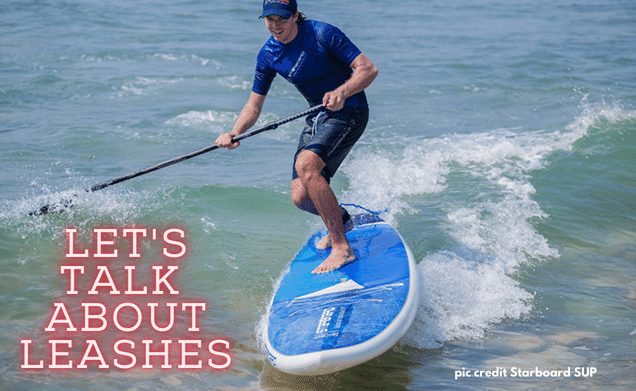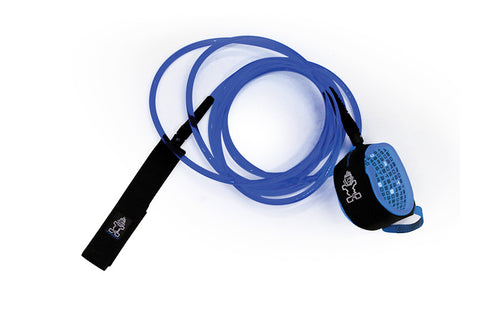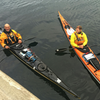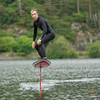Are you using the correct SUP leash?

A fundamental part of your SUP safety equipment is your board leash.
Often overlooked, this small piece of kit has the potential to make a massive difference to your SUP experience. There are a variety of leash options to choose from and it is important you choose the correct leash for your paddling environment. In this article we are going to go through some of the different options currently available with an brief explanation for each.
Before we get going it’s important to remember that your paddling safety consists of more than using the correct leash, even with the best leash for the environment you’re paddling in accidents are still possible. The leash you use is one component of a much larger safety approach which starts before you get anywhere near the water. Our last blog post included some SUP safety considerations and planning which is available here if you haven’t already seen it.

Most boards are sold with a leash but don’t assume the leash that came as part of the board package is the best one for you. It’s time to think about where you’re going to be paddling and whether the leash you have is the most appropriate.
If your board didn’t come with a leash, or it came with a leash that isn’t suitable then it’s time to part with a few pounds. Let’s remember the main function of a leash is to act as the connection between the paddler and the board so that the board isn’t washed or blown away if you fall in. Most good leases do this well but in certain scenarios the same leash could become a lethal hazard. This short video clip demonstrates the danger of leash entrapment really well and we would encourage everyone to have a watch.
There are three main leash categories we are going to cover “straight”, “coiled” and “waist”.
Straight Leash = Good for surfing

If your plan is to surf waves at the beach on your SUP a straight leash is the logical option for you to consider. They are sold in various lengths so you need to choose the best length for your board. As a rule of thumb your leash should be close to the same length as your board. Where you attach the velcro cuff is a case of personal preference with folks going for either ankle or calf attachments. The main part of the leash is made of shock absorbing rubberised cord that is designed to stretch if you end up falling off in the white water with the board getting dragged away from you in the wave. Once the wave power eases you can retrieve your board using the leash.
While straight leashes work really well in surf, in all other environments they should really be avoided due to the fact that most of the leash will be trailing through the water as you paddle. This creates drag and more worryingly a snag hazard.
Coiled leash = Good for water with no flow or current.

For the purposes of this article we are classing flowing water as any body of water that has a current or flow regardless of its strength or speed.
If you’re SUP racing or SUP touring on anything other than flowing water coiled leashes would be an option. This is because the leash stays out of the water as it is made of a coiled cord which effectively shortens the leash length and reduces the likelihood of it dragging through the water. In the event of you falling in the coiled section extends so that there is a bit of distance between you and the board. They are normally attached around your ankle or calf using a velcro cuff. They can also be attached to a waist worn quick release belt, (more on this shortly).
Something to be aware of with coiled leashes is the speed the board springs back towards you. In some cases it can be quicker than a straight leash which is why they aren’t the best option in surf. If you’re not ready for the recoil it could catch you by surprise and leave you with a bruise or potentially damage your kit. An important point to highlight. You should not use a coiled leash attached to your lower leg or ankle if you are planning to paddle in moving water as it can be impossible to release if you fall in and become trapped by the flow of the water.

Waist leashes = Good for all environments.


As SUP has evolved and people have explored new environments the evolvement of equipment has naturally followed. After a few near misses and a some tragic incidents it became apparent that attaching a leash around your leg or ankle while in moving water has the potential to cause a lethal accident. Leg worn leashes need to be released by undoing the velcro, if you can’t reach the velcro you can’t release the leash.
This becomes extremely dangerous if your board gets washed one side of an obstruction while you get washed around the other side of the obstruction. In flowing water the board will act like an anchor, with the flow of water pressing you under the water surface and stopping you from being able to bend to a point where you can reach your ankle and undo the velcro.
This is why in any flowing water a waist leash with a purpose built quick release system is the only option to consider. A waist leash system will incorporate some form of shock absorbing cord and a belt. Some products even include a “weak point” that will give way under load so that the wearer doesn’t need to pull the quick release buckle.
Often people use a coiled leash but instead of fastening it to the leg they fasten it to the quick release point on the waist belt. It is important that the waist belt is accessible so you should wear it on top of all your other layers. With the toggle of the quick release buckle easily accessible it should be a simple case of pulling the toggle to release the leash from the belt and detaching yourself from your board. It goes with out saying that once you have disconnected yourself from the leash it is unlikely that you will be able to rely on your board for buoyancy.
It’s worth considering that waist leashes work well in all SUP disciplines so if you’re only going to buy one leash make it a waist leash. Before you hit the water though make sure you’ve set it up properly and have a practise at releasing the quick release buckle. It’s worth doing it a few times adding in some kind of variety, for example spin the belt round your body so the buckle isn’t always in the same place. Try it with you eyes closed and try it under load.
To Summarise...
Straight leash attached to the lower leg.
Pros
- Secure way to connect yourself to your board while you are surfing.
- Provides some distance between you and your board if you fall in while surfing waves.
Cons
- Dangerous in flowing water.
- Can wrap around your feet as you move around on the board.
- It's usual for a section of the leash to trail through the water causing additional drag and a potential hazard.
Coiled leash attached to the lower leg.
Pros
- Secure way to connect yourself to the board in non flowing water.
- Less likelihood of of it wrapping around your feet as you move around on the board
- Unlikely to trail through the water while you're paddling.
Cons
- Dangerous in flowing water.
- Can act like a spring as it recoils after being stretched making it not ideal for surf.
Waist leash with quick release buckle.
Pros
- The safest leash option available.
- Works well in multiple environments.
- Provides an option for easy release in an emergency.
- Allows you to move around the board without tripping on the leash.
Cons
- Requires a bit of training.

We would encourage you to seek further guidance from an appropriately qualified and experienced person or organisation if you are in any doubt about your SUP plans. Enjoy the planning phase of your SUP activities, stay safe and maximise your time on the water.
If you have any questions or comments about choosing a suitable SUP leash please feel free to give us a shout, you can contact us in all the usual ways.
-
Posted in
safety




